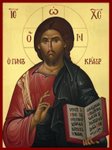 As I have done in the past, I am cross-posting these reflections from the "Into the Deep" blog.
As I have done in the past, I am cross-posting these reflections from the "Into the Deep" blog.I have spent the summer studying Josef Ratzinger's (Pope Benedict XVI) book Jesus of Nazareth (New York: Doubleday, 2007) . I am quite sure that there are many, many excellent blogs out there commenting on this text. I, with a lot of coercion from certain individuals, will add my voice to the chorus. I hope not to just tell you what the text says - you can read that for yourself. What I hope to do is to take selections of the text that strike me and reflect upon them. These reflections might concern theological or spiritual topics depending on what facet I extract. All this is done on hopes of getting folks to read the book themselves so as to reflect and meditate on Jesus, through the discussions in the book, in their own lives.
Thus, I will be skipping all over the place within the book according to my fancy. The first set of reflections comes from close to the end of the book. Chapter 9 is titled Two Milestones on Jesus' Way: Peter's Confession and the Transfiguration. Within the section on the Transfiguration, Ratzinger discusses an idea that he has spoken of earlier in the book, viz., the importance of the symbol of the mountain throughout the Gospels. He lists seven different "mountains" that Jesus experienced throughout his earthly life.
- The Mountain of Temptation
- The Mountain of His Great Preaching
- The Mountain of His Prayer
- The Mountain of the Transfiguration
- The Mountain of His Agony
- The Mountain of the Cross
- The Mountain of the Risen Lord
Jesus Himself told us that we must pick up our cross, deny ourselves, and follow him daily (Luke 9:23). Thus, we must journey to each of these mountains in order to live the life of Jesus - "It is no longer I who live, but Christ who lives within me." (Galatians 2:20) Over the next few weeks, I will take each of the "mountains" and reflect on its importance in Jesus' life and what it means for ours.
In general, the mountain serves throughout the Scriptures, but especially in the Gospels, as a place of the exceptional closeness of God. Ratzinger states:
The mountain is the place of ascent - not only outward, but also inward ascent; it is a liberation from the burden of everyday life, a breathing in of the pure air of creation; it offers a view of the broad expanse of creation and its beauty; it gives one an inner peak to stand on and an intuitive sense of the Creator.
The mountaintop is a place of vision. We can see for long distances across many obstacles that block our view from the valley floor. We need a vision. It gives us a vector to travel on; a direction to our life. A vector designates magnitude and direction. The vision that God gives us from the mountaintop typically has these attributes; we get a real sense of where he is calling us along with a sense of the price that must be paid. Of course, these don't come in fine detail. God paints these scenes with a broad brush but with enough detail we can begin the journey with enthusiasm and anticipation. It is essential to inscribe these times of vision on our hearts for there will come a time in the valley where we will walk by the darkness of faith and the remembrance of the mountaintop will be the manna that feeds us in the wilderness.
We cannot choose the time for the mountaintop nor bring it about. We can only wait in vigil as the disciples, along with the Blessed Mother, waited in the Cenacle (upper room) for the coming of the promised Paraclete (Cf. Acts 1:14). Rest assured, God has a vision for you. He is anxious to share what that is. As he says in Jeremiah:
For I know the plans I have for you, says the LORD, plans for welfare and not for evil, to give you a future and a hope. (29:11)
However, we must be available to the Lord and willing in order to share in it. We must be taking the time for prayer so that we are available to the Lord when he desires to take us there. Moreover, we must have a deep conviction and attitude of surrender. The Lord likes nothing more than to have permission from us to do to us as he pleases. It demonstrates a deep faith and trust within the disciple. It is in this disposition of trust and faith that God can lead us to where he is calling us. One thing we must always keep in mind (we will discuss this more when we discuss the "Mountain of the Transfiguration") is that the mountain always leads to the valley where the Cross awaits. All trails off the mountain lead to the self-sacrificing love as expressed through redemptive suffering. If Jesus could only bring salvation tot he world through the suffering of the Cross, then we can't expect to serve him in any capacity that doesn't lead directly through where he has been. As we journey from mountain to mountain, the one feature that we will always find is the Passion. Let us not be discouraged by the ubiquitous presence of the Cross but take comfort and consolation in the fact that we are being treated as the Son was, and, if we share in the death of the Son, we will share, also, in his eternal life.
Thus, let us strap on our hiking boots and clothe ourselves in a deep confidence and trust in God. Let us allow him to lead us through these mountains as we allow him to conform us to the image of his Son. Then we can say with St. Paul in his letter to the Galatians:
I have been crucified with Christ; it is no longer I who live, but Christ who lives in me; and the life I now live in the flesh I live by faith in the Son of God, who loved me and gave himself for me. (Galatians 2:20)



No comments:
Post a Comment